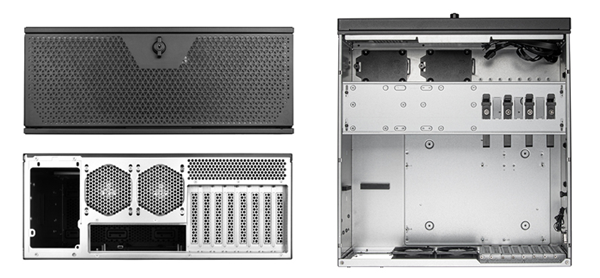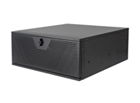What is a Rackmount GPU Workstation?
A GPU workstation is a powerful computing machine designed specifically to perform highly demanding and complex graphical computations using high-performance graphics processing units (GPUs). These workstations are often used for applications such as 3D modeling, scientific simulations, and video editing that require real-time rendering and processing of large amounts of graphical data. By harnessing the power of parallel processing offered by GPUs, GPU workstations can process large amounts of data in a fraction of the time required by traditional CPU-based workstations.
GPU workstations are built with high-end components such as powerful processors, large amounts of memory, and fast storage drives to handle the intense computational demands of these tasks. Additionally, they are optimized to efficiently perform parallel computations using the GPU, which is designed to handle a large number of processing tasks simultaneously. The ability to parallelize computations allows GPU workstations to process large amounts of data much faster than traditional CPU-based workstations, making them ideal for complex graphical applications.
GPU workstations are used in a variety of industries, including architecture, engineering, and entertainment, where high-performance computing is critical to success. These industries often require the ability to process large amounts of data in real-time, making GPU workstations an essential tool for professionals in these fields. While GPU workstations can be expensive due to the high-end components required, they offer significant performance improvements compared to traditional CPU-based workstations for tasks that require high levels of graphical processing.

Features of a Rackmount GPU Workstation
A rackmount GPU workstation typically has several features that make it optimized for graphics-intensive workloads. Here are some key features you might find in a rackmount GPU workstation:
- Powerful Graphics Cards: A rackmount GPU workstation typically has one or more high-performance graphics cards to provide the necessary graphics processing power. These graphics cards may include NVIDIA or AMD GPUs with large amounts of dedicated video memory.
- Specialized Cooling Systems: The high-performance graphics cards in a rackmount GPU workstation generate a lot of heat, so these systems often have specialized cooling systems to dissipate that heat. These cooling systems may include multiple fans or liquid cooling systems.
- Large Amounts of Memory: A rackmount GPU workstation often has a large amount of system memory (RAM) to support graphics-intensive applications. This memory can be used for tasks such as caching textures and frames, and can help improve overall performance.
- High-Speed Storage: To support fast data transfer rates, a rackmount GPU workstation may include high-speed solid-state drives (SSDs) or NVMe storage. This can help speed up the loading and saving of large files and improve overall system performance.
- Multiple PCIe Slots: A rackmount GPU workstation may have multiple PCIe slots to support additional graphics cards or other expansion cards, such as network interface cards (NICs) or storage controllers.
Components of a GPU Workstation
The components of a rackmount GPU workstation will vary depending on the specific configuration and use case, but here are some of the most common components you can expect to find:
- Motherboard: The motherboard is the main circuit board that connects all the other components together. It provides power and communication pathways for the CPU, RAM, and other components.
- CPU: The central processing unit (CPU) is the main processor that performs most of the calculations in the system. For GPU workstations, high-end CPUs with multiple cores are often used to handle parallel processing tasks.
- RAM: Random access memory (RAM) is used for temporary data storage while the system is running. For GPU workstations, large amounts of high-speed RAM are often used to support large datasets and memory-intensive applications.
- Graphics card(s): The graphics card (or cards) is the main component that provides the processing power for graphics-intensive workloads. High-end graphics cards with dedicated processors and large amounts of memory are often used in GPU workstations.
- Storage: Storage devices, such as solid-state drives (SSDs) or hard disk drives (HDDs), are used to store data and applications. For GPU workstations, high-speed storage devices are often used to support fast data transfer rates and quick access to large datasets.
- Power supply: A power supply unit (PSU) is used to provide power to all the components in the system. For GPU workstations, high-capacity power supplies with multiple outputs are often used to support the high power demands of multiple graphics cards.
- Cooling: Cooling is a critical component of GPU workstations, as high-performance graphics cards generate a lot of heat. Specialized cooling systems, such as liquid cooling or large fans, are often used to keep the system cool and prevent overheating.
What's the Difference Between a Rackmount GPU Workstation and a Rackmount Computer?
Rackmount GPU workstations and rackmount computers are similar in that they are both designed to fit into standard server racks and provide high-performance computing power. However, there are some key differences between the two.
A rackmount GPU workstation is specifically designed for applications that require significant graphics processing power, such as gaming, video editing, and 3D rendering. These workstations are optimized for the specific needs of graphics-intensive workloads and typically have more powerful graphics cards and specialized cooling systems.
On the other hand, a rackmount computer is a more general-purpose system that can be used for a wide range of computing tasks, from data analysis and server hosting to running virtual machines and performing scientific simulations. Rackmount computers typically have a variety of configuration options, including the ability to add GPUs for increased computing power.
In summary, if you need a high-performance computing system for graphics-intensive workloads, a rackmount GPU workstation may be the best choice. However, if you require a more general-purpose computing system that can be used for a range of tasks, a rackmount computer may be more appropriate. Ultimately, the choice between a rackmount GPU workstation and a rackmount computer depends on the specific needs of your application and the resources available to you.
Why Should You Consider Getting a Rackmount GPU Workstation?
You should consider getting a GPU workstation if you need high-performance computing capabilities for graphics-intensive workloads.
- Faster processing times: GPUs are designed to handle parallel processing tasks, which means they can perform calculations much faster than traditional CPUs. This makes GPU workstations ideal for applications that require a lot of processing power, such as 3D modeling, scientific simulations, and machine learning.
- Better graphics performance: GPU workstations are optimized for graphics-intensive applications, such as video editing, game development, and CAD. The dedicated graphics card(s) in a GPU workstation can provide better graphics performance and support higher resolutions and frame rates than integrated graphics solutions.
- Increased productivity: With faster processing times and better graphics performance, GPU workstations can help you get more work done in less time. This can be especially important for professionals who need to work with large datasets or complex simulations.
- Customizable configurations: GPU workstations can be customized to meet your specific requirements. You can choose the components that best suit your needs, such as high-end graphics cards, large amounts of RAM, or fast storage devices.
- Scalability: GPU workstations can be scaled up to support larger workloads or scaled down to meet changing needs. You can add or remove components as needed to optimize performance and cost.
Overall, if you work with graphics-intensive applications or need high-performance computing capabilities, a GPU workstation can provide the processing power and graphics performance you need to get your work done faster and more efficiently.





